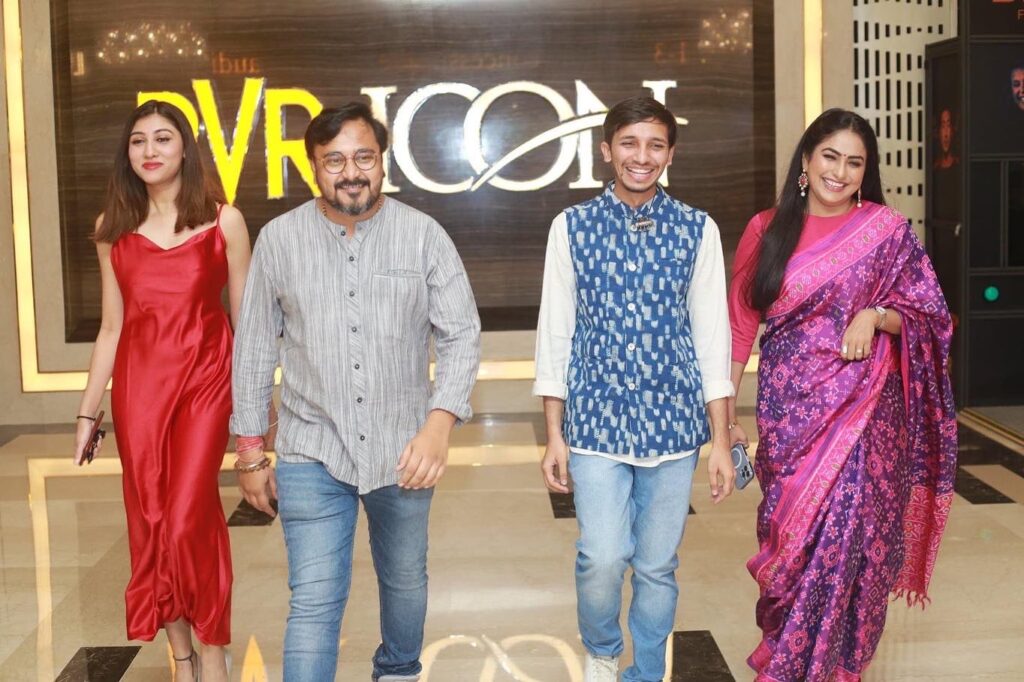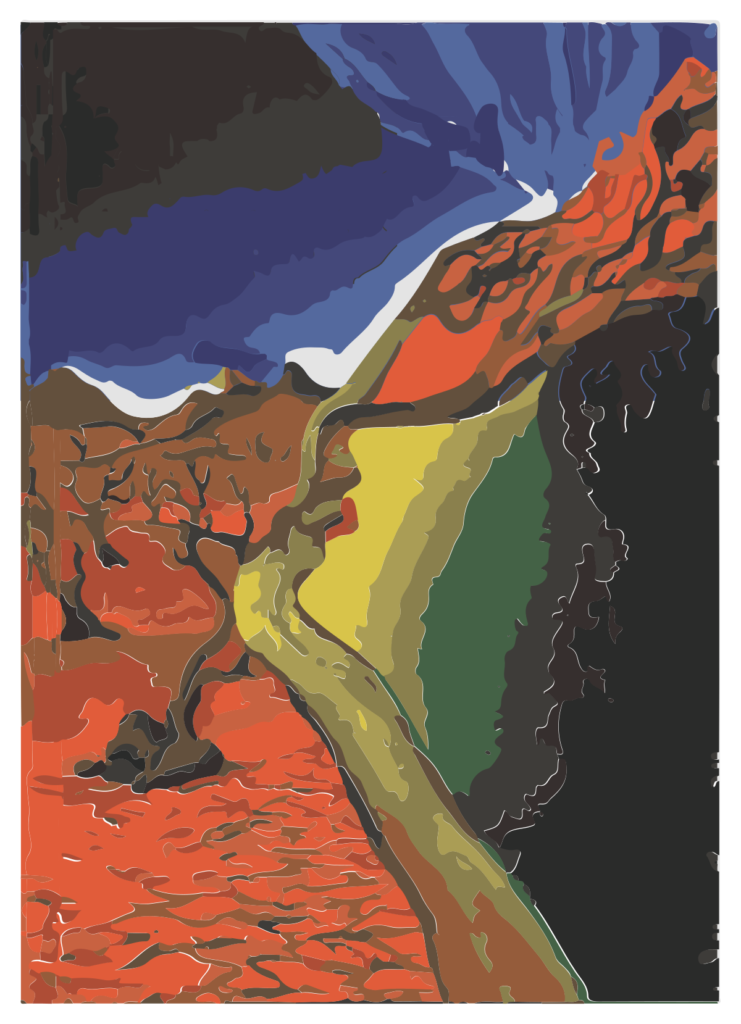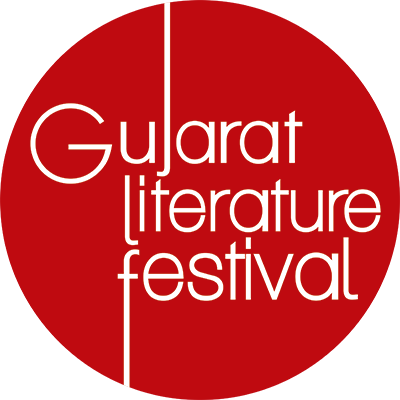
“Today’s yug or time is for writers to focus on How to tell a story rather than What to tell,” said 29-year-old storyteller, screenwriter and columnist Raam Mori.
In 2018, Raam bagged the ‘Most Promising Young Writer’at Gujarat Literature Festival. Cut to 2021, Mori became a household name. His story ‘21mu Tiffin’ from his book ‘Mahotu’ turned into a film directed by Vijaygiri Bava. It was screened at the 52nd International Film Festival of India, in the Indian Panorama Feature Film Section, shown in the UNESCO-ICFT Gandhi Medal Competition on November 22, 2021.

What is trending in the world of Gujarati literature?
Writers born today, by which I mean born in the era of Netflix, Amazon Prime, Disney plus Hotstar etc, are competing directly with a strong visual medium. They are competing against several cups of coffee and popcorn served while watching a vast OTT platform!
So, when I am teaching in a class or meeting my fellow writer friends, I often tell them that the entire writing game is no longer about “what to tell?” It is about “How to tell?”
Writers and books are directly competing against several forms of entertainment. Earlier, the visual medium offered limited choices, so readers or viewers resorted to books. But now, there are bouquets of visual content up for grabs for our readers-turned-viewers. In addition, they lack patience and want a break to binge-watch their favourite shows.
One must remember there are only Seven Stories or Seven Types of stories that every writer tells. So, when someone says their story is new; nobody has ever done this before; it is a lie. Vyasa, the sage, was a great storyteller who wrote the Mahabharata. The story has several plots and subplots, and more. How different will your story’s plot or subplot be from what’s already written in the Mahabharata?
Writers must snap out of the bubble that their story stands out! Instead, focus on how to tell a story!
What is a zero budget cinema? An innovative and fantastic way to visualise a short story. Create your internal journey and showcase it.
Do you know why Manav Kaul is so read or famous? People love his works. He thrives on the new-age form of caption literature. Kaul has published around eight to nine books, including a compilation of poetries. His bestseller is the book on caption literature—based on his posts written on his Instagram handle. People can relate to him because his works celebrate aloneness, and many around us feel alone.
Kaul, Divyaprakash Dubey, and Satyajit are from the popular culture of nayi wali Hindi writers.
While tools and means of communication have risen, people are communicating less. There are multiple routes or ways of expressing your feelings, thoughts and emotions, for instance, Facebook questions as soon as you log in, ‘What’s on your mind?’ But the mind only has emojis!
Our communication has turned short, making people feel lonely. Today, the generation is turning emotionally blank, and nobody is teaching them how to react. We all are living in an emotionally confused world right now. So, the more internal journey the writer takes us in, the more the writer’s works will sustain and the more it will last.
Caption literature and changing the presentation of story-telling will also change the language. Do you think that would justify the vast literature we have?
Literature is no different from language—they are interlinked, intertwined with each other. Every language has its literature and vice versa, yet, they are different.
Gujarati literature once had the “Pandit Yug” where characters would use words like mahra (માહરા), tamhara (તમહારા), aaj maharah mahra uddhaar ma (આજ મહારાજ માહરા ઉધ્ધાર મા), uge chhe surkhi bhari ravi (ઉગે છે સુરખી ભરી રવિ) —to converse.
At that time to understand what the characters spoke in the story, the readers ought to understand the play of words and the sheer richness of it used to converse in everyday life. One had to have the knowledge and skill of how to use the language to get the work done. Communication did not matter at all.
And because it was Pandit yug, pandits or sages wrote books, who wanted their readers to be pandits too! By which I mean, their readers had to become devotees of Gujarati literature and be well equipped to acquire, understand and take within them Gujarati writings of that era.
Then Mahatma Gandhi gave a diktat to creators of Gujarati literature, “Litterateurs should write in a language understood by all–the common individual walking on the street or working in your house, a vegetable vendor, your laundryman, et al.” This bar, set by Gandhiji impacted writers from Kakasaheb Kalelkar to Swami Anand. Every writer started writing in this language and this was the Gandhi Yug of Gujarati Sahitya—the time and era when literature became easy to read and understand and was available to all. Soon, Gujarati literature got writers who started writing on everyday topics.
Novels written by Saraswatichandra or Govardhan Tripathi were perhaps not relatable to a lady selling vegetables on the street sweeper, as words were heavy, sounded poetic and difficult to decipher. It sounded and felt like living in a Sanjay Leela Bhansali film!
But when Pannalal Patel wrote Manvi ni Bhavai (માનવી ની ભવાઈ), Malela Jeev (મળેલા જીવ ) or when Zaverchand Meghani and Chunilal Madia wrote stories in the Gandhi yug, it reached everyone. All the stories written by Gaurishankar Joshi, AKA Dhumketu, are the most magical, as the characters are easily relatable. Slowly, literature made sense, and people realised that their everyday lives could also be a part of Gujarati literature.

Then came Ramesh Parekh, a golden chapter perhaps in Gujarati literature who gave us poetries that read ek chokri na haat ma thi rumaal pade, ane jova gaam aakhu tole pade (એક છોકરી ના હાથ મા થી રૂમાલ પડે અને જોવા ગામ આખું તોલે પડે ). Similarly, Balmukund Dave wrote in a language that was easy and very close to folk songs (lok geet). People could relate to poetries and feelings attached to words. I am not a poet and I am telling this purely based on what I have read so far. The genre is huge and my reading in that genre is limited.
Then came the 80s, the time for modern manuscripts, when the likes of Suresh Joshi, who were impressed by western literature and were happy with their terms and theories, started contributing to Gujarati literature. Western literature was their first choice, but soon modern literature made a deadly discovery. Writers decided to write, irrespective of whether or not their readers understood their works because writers wanted readers to read as much as possible. It gave rise to a different kind of competition on who will show their scholarly prowess! Who can write the difficult work of all time? It gave rise to different types of literary works, and readers became less interested, for they thought that this kind of work was perhaps not meant for them. But they never left Gujarati literature, all because of Chunilal Madia, Zaverchand Meghani, Pannalal Patel, Kanhaiyalal Munshi, Gunvantrai Acharya, and others. The new writers kept fiction writing alive.
Literature is a reflection of the times and era we live in. My first book, “Mahotu” written in 2012-13, is a collection of 14 stories, seven each, in rural and urban areas. All the stories connected with my readers instantly, for their conversations centred on current time and location. Your audience should not be confused between 1922 and 2022. I believe and assert that sahitya samaj nu ane samay nu dastavej chhe (a literature is a reflection of the time and society we live in). It is the writer’s responsibility to be aware of the language and background he or she represents.
What’s your take on the use of English words in Gujarati literature?
Currently, creative liberty is the thing, so every writer to their own! Then there is kavi karma, sarjan karma, varta karma—where every writer jumps on the bandwagon on their terms and conditions. Fine, go ahead, but here I would like to quote poet Manilal H Patel, “લેખક લખવાનું કામ કરે છે, વાચક વાંચવાનું કામ કરે છે અને ત્રીજો કામ કરે છે કાળ નો ઘંટલો. એટલુંજ કશે, જે એ સમય ની માંગ હશે (In other words, a writer writes, a reader reads only time will decide what shall stay and what shall perish.)
Does literature lose its sheen?
There is no way one can save literature. Priyakant Parikh, a writer, wrote 100 novels, but I doubt if any readers would remember even five names. There will be attempts to save such forms of literature, but then who are its readers? I believe every story has an energy that attracts readers. When you are reading, perhaps somewhere you feel it is your story, or you are living the life. At some point when readers connect to the story, those stories live the longest. Literature with several long windows and doors can have a longer shelf life.
This interview was conducted for GLF by Kinjal Shah

Thank you for another informative website. Where else may I get that kind of info written in such a perfect way?
I’ve a undertaking that I am simply now working on, and I’ve been at the look
out for such info.
Asking questions are genuinely good thing if you are not understanding something
totally, but this article provides good understanding yet.
Thanks for any other wonderful article. Where else may anybody get that kind of information in such a perfect method of writing?
I’ve a presentation subsequent week, and I’m at the look for such info.
Greetings from Colorado! I’m bored at work so I decided to check out your site on my iphone during lunch break.
I love the knowledge you provide here and can’t wait to take a look when I get home.
I’m amazed at how fast your blog loaded on my mobile ..
I’m not even using WIFI, just 3G .. Anyhow, wonderful site!
Nice post. I was checking continuously this blog and I am impressed!
Very helpful info specifically the last part 🙂 I care for such information a
lot. I used to be seeking this particular information for a very lengthy time.
Thank you and best of luck.
We absolutely love your blog and find almost all of your post’s to be exactly I’m
looking for. can you offer guest writers to write content
for you personally? I wouldn’t mind producing a post or elaborating on some of the subjects you write related to here.
Again, awesome site!
Amazing! This blog looks just like my old one!
It’s on a totally different topic but it has pretty much
the same layout and design. Great choice of colors!
Nice post. I was checking constantly this weblog and I
am inspired! Extremely useful information specially the
final phase 🙂 I deal with such information a lot.
I used to be seeking this certain info for a long time.
Thank you and best of luck.
Hi there! This blog post could not be written any better!
Going through this article reminds me of my previous roommate!
He continually kept talking about this. I am going to
forward this information to him. Pretty sure he’ll have a great read.
I appreciate you for sharing!
Unquestionably imagine that which you said. Your favourite justification seemed to be
on the web the easiest factor to keep in mind of.
I say to you, I definitely get irked while other folks consider
concerns that they plainly don’t realize about.
You managed to hit the nail upon the highest as smartly as outlined out the entire thing with no need side-effects
, people can take a signal. Will probably be again to get more.
Thank you
Thank you for the auspicious writeup. It in reality was a leisure account it.
Look advanced to more added agreeable from you! By the way,
how can we be in contact?